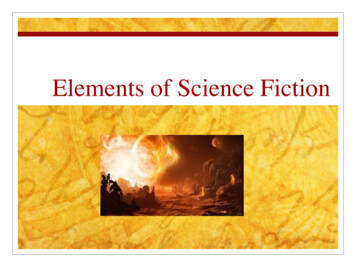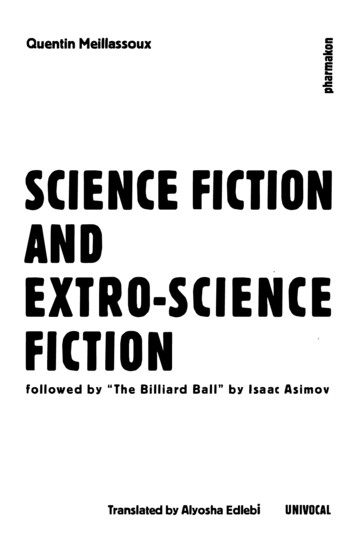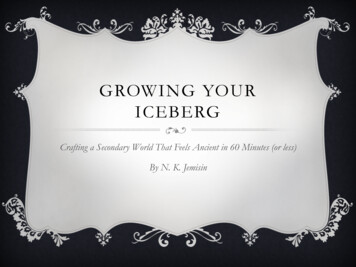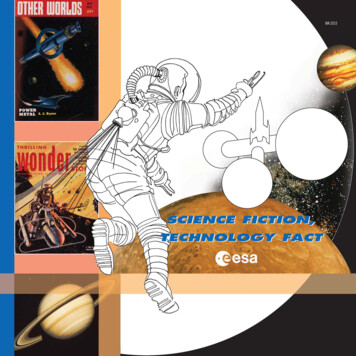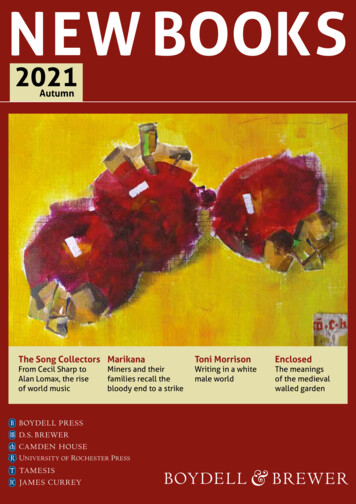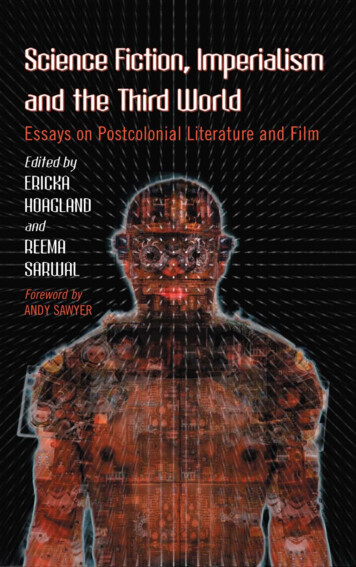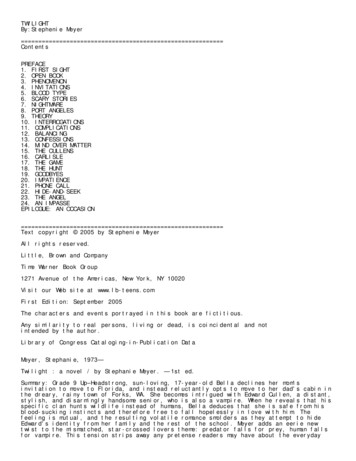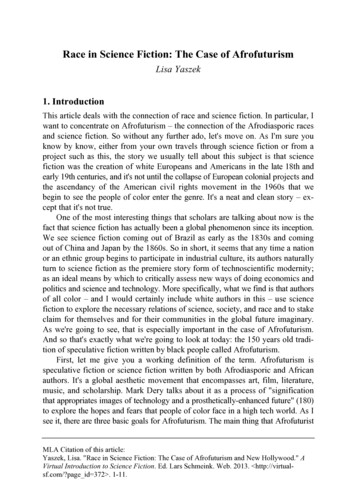
Transcription
Race in Science Fiction: The Case of AfrofuturismLisa Yaszek1. IntroductionThis article deals with the connection of race and science fiction. In particular, Iwant to concentrate on Afrofuturism – the connection of the Afrodiasporic racesand science fiction. So without any further ado, let's move on. As I'm sure youknow by know, either from your own travels through science fiction or from aproject such as this, the story we usually tell about this subject is that sciencefiction was the creation of white Europeans and Americans in the late 18th andearly 19th centuries, and it's not until the collapse of European colonial projects andthe ascendancy of the American civil rights movement in the 1960s that webegin to see the people of color enter the genre. It's a neat and clean story – except that it's not true.One of the most interesting things that scholars are talking about now is thefact that science fiction has actually been a global phenomenon since its inception.We see science fiction coming out of Brazil as early as the 1830s and comingout of China and Japan by the 1860s. So in short, it seems that any time a nationor an ethnic group begins to participate in industrial culture, its authors naturallyturn to science fiction as the premiere story form of technoscientific modernity;as an ideal means by which to critically assess new ways of doing economics andpolitics and science and technology. More specifically, what we find is that authorsof all color – and I would certainly include white authors in this – use sciencefiction to explore the necessary relations of science, society, and race and to stakeclaim for themselves and for their communities in the global future imaginary.As we're going to see, that is especially important in the case of Afrofuturism.And so that's exactly what we're going to look at today: the 150 years old tradition of speculative fiction written by black people called Afrofuturism.First, let me give you a working definition of the term. Afrofuturism isspeculative fiction or science fiction written by both Afrodiasporic and Africanauthors. It's a global aesthetic movement that encompasses art, film, literature,music, and scholarship. Mark Dery talks about it as a process of "significationthat appropriates images of technology and a prosthetically-enhanced future" (180)to explore the hopes and fears that people of color face in a high tech world. As Isee it, there are three basic goals for Afrofuturism. The main thing that AfrofuturistMLA Citation of this article:Yaszek, Lisa. "Race in Science Fiction: The Case of Afrofuturism and New Hollywood." AVirtual Introduction to Science Fiction. Ed. Lars Schmeink. Web. 2013. http://virtualsf.com/?page id 372 . 1-11.
2Lisa Yaszekartists want to do is tell good science fiction stories and I think that if you speakwith any black science fiction author from anywhere around the globe, they'lltell you that's first and foremost what they're interested in. But there are two otherpolitical goals associated with Afrofuturism as well. Afrofuturist artists are interested in recovering lost black histories and thinking about how those historiesinform a whole range of black cultures today. They also want to think about howthese histories and cultures might inspire new visions of tomorrow.Let's think a little bit more about these last two goals. A lot of scholars thinkabout Afofuturism as an extension of the historical recovery projects that blackAtlantic intellectuals have engaged in for well over two hundred years now. AsTony Morrison has written and spoken about eloquently, these kinds of historicrecovery projects show how African slaves and their descendants experiencedconditions of homelessness, alienation, and dislocation that very much anticipatewhat Nietzsche described as the founding conditions of modernity (cf. Gilroy).And so, you can start to see why it is that science fiction appeals to Afrodiasporicartists. If you want think about black people as the primary subjects of modernity,those who have the most intense engagements with it, science fiction has thegrammar that allows us to narrate those engagements. Stories about travelthrough time and space and stories about encounters with the alien other are idealways to bring those historical experiences to life for new audiences. Just to jumpahead of myself here for a moment, if you think about Derrick Bell's story "TheSpace Traders", you can see how the lead character, Professor Golightly, is alwaysengaging African American history in his attempt make sense of an uncertain future,and that's what allows him to realize that the United State's deal with the aliens maynot end all that well. That attempt to connect the past with the present and thefuture is central to the Afrofuturist project.The next goal for Afofuturists is a more positive one: not just to rememberthe bad past, but to use stories about the past and the present to reclaim the historyof the future. That is what African-British music critic Kodwo Eshun talks aboutin his really great work on Afofuturism. He talks about how histories of the future have been hijacked by what he calls "the futures industries" (290). "The futures industries" is his term for the place where technoscience, fictional media,and market prediction meet – especially as the ideas generated by those industries are conveyed across the globe by the mass media. What you tend to see inthe mainstream media, again and again and again, is the sense that blackness is acatastrophe. Black spaces are zones of absolute dystopias where either capitalismhasn't had a chance to intervene yet or where capitalism has failed. We see thisagain and again in the news: black cities are always depicted in dystopic ways.Africa is a gigantic continent, with lots of different ecosystems and cultures andnations and people and events and histories, and yet its always treated somehow
Race in Science Fiction3as THE place of dystopia, plagued by drought, AIDS, and famine, and we rarelyhear positive things about progress in African unless it is in terms of capitalistintervention.For Eshun, Afrofuturism is important because it is a kind of storytelling thatgives authors a public means by which to intervene into those bad futures thatare written by the futures industry and to challenge them, change them, write altogether new ones. Interestingly, Eshun riffs a bit on W.E.B. Dubois when hetalks about this. As some of you might know, Dubois was an African Americansociologist who wrote science fiction and who coined the term "double consciousness," (Souls 8) which means that black people always live under the consciousness of being both African and American. What Eshun sees as valuableabout Afrofuturism is that it has the ability to enhance double consciousness andeven to triple or quadruple or quintuple consciousness, to give us a sense thatthere are a lot of different ways to think about being black and to think about therelations of the science, society, and race. This allows authors to create complexfutures in full color rather than ones that are either simply white washed utopiasor black dystopias.2. Afrofuturism in the United States: 1850-1960So now that I've given you a little bit of background on the goals of Afrofuturism,I want to take you through a brief history of this genre and give you some readingrecommendations. The first period I want to write about here is a long one – thedevelopment of Afrofuturism in the United States, which happened from about1850 to 1960. This period, as you know, marks the establishment of science fictionas well as Afrofuturism and both were popular genres with a lot of similaritiesfrom the very beginning. Both science fiction and Afrofuturism were generallywritten at first by respected mainstream writers who were experimenting with avariety of emergent genres. A few famous examples of early sf authors are MaryShelley, who played with the Gothic and writes proto-sf in Frankenstein (1818);H.G. Wells, who perfected the future war story in The Battle of Dorking (1871)and War of the Worlds (1898); and Edward Bellamy, who updated the utopia tospeak to the industrial age and created a new form, the techno-utopia, with LookingBackwards (1887).We see a similar trend in American Afrofuturism at this point in time. Forinstance, Charles Chestnutt was a mainstream writer who wrote short stories suchas "The Goophered Grapevine" (1887), which is a gothic commentary on USracism that revolves around white northerners who come to the south and have
4Lisa Yaszekto deal with the history of racism and of slavery as that history has impacted thevineyard that the northerners are buying.Sutton E. Griggs' Imperio in Imperium (1899) is a future war story where USblacks take up arms against their white oppressors. It's a fascinating story because throughout most of the novel, one protagonist is much more peaceful thanthe other. In looking for an integrated solution to racism, that particular protagonist tries every technoscientifc means possible. In particular, he tries to educateblacks to become engineers and agriculture experts and to show that they can bemodern technocultural citizens. Finally that fails and the other protagonist encourages black people pick up arms and "not shirk war, if war is forced" (245),thus calling for a future, no matter the means necessary.A final important story from this time period is Edward A. Johnson's NewLight Ahead for the Negro (1904), which imagines a scientific agricultural utopia predicated on black knowledge and industry. So that's a story in which blacksessentially transform America into a more productive and racially integrated country by leveraging the technoscientific knowledge that they gained as slaves andthe education they gained as free people to build a better south.That takes us through the roots of Afrofuturism. The genre continued to developin the early 20th century in a way that we might describe as 'separate but equal.'You may or may not be familiar with this phrase, but it was central to Americanpolitics and society at the turn of the 20th century and was supposed to meanthat blacks and whites could share equally in America's resources but keep theircultures distinct from one another. And while this did indeed encourage the development of two separate societies, they were not equal by any stretch of theimagination. Instead, the rhetoric of 'separate but equal' became a way to keepmost resources in the hands of whites and away from blacks. Now, let's take thatback to science fiction publishing at the turn of the 20th century, where we findthat black and white authors alike are writing science fiction, but publishing indifferent venues. For the most part, white authors published in white owned andoperated magazines like Weird Tales and Amazing Stories and Astounding ScienceFiction. Meanwhile, Afrofuturist authors published in primarily black owned andoperator newspapers like The Crisis and the Pittsburgh Courier.What's particularly interesting in this case is that this wasn't a separate butequal policy enforced by whites, but instead seems to have been chosen by blackauthors themselves. There seems to be a number of reasons for this collectivedecision. One point that Samuel Delany makes is that a lot black authors avoidedthe genre magazines because they looked so frivolous. If you look at the imagesof covers and inside the magazines, you can see how The Crisis sometimesprinted science fictional covers, like the September 1927 issue of a giganticwoman holding the sun up over a little tiny city. In some ways this anticipates
Race in Science Fiction5campy Hollywood science fiction movies of the 1950s, but the actual design isvery much part of the modernist art movement and so signals 'high literature' ratherthan 'genre literature.' By way of contrast, covers from Amazing Stories werevery straightforward and meant to appeal to readers on a visceral level: youknow when you read this it won't be a metaphor for anything, you're really readinga story about tiny men fighting gigantic bugs. And so you can imagine that someauthors might have felt if you're going to try to publish a story about black revolution or black technoscientific genius, it might not be taken particularly seriouslyin magazines about tiny little white people fighting gigantic bugs.Image: Issue of The Crisis, September 1927 and Issue of Amazing Stories, July 1926.The other reason that black authors don't seem to have published much in theearly genre magazines is, quite simply that there were indeed a number of raciststories published in those magazines. Perhaps the most famous example of thisis Stanley G. Weinbaum's "A Martian Odyssey", a story from 1932. This is a storythat often treated as central to science fiction history because it is sympathetic tothe alien other and tries to find connections between humans and aliens. Up untilthat time, you didn't see that many stories like that. Of course the problem is thatthe humans populating Weinbaum's story know that the Martians they encounterare intelligent and rational beings precisely because their knowledge classificationsystems are more sophisticated than those of African people on earth. So the storysuggests that you cannot be a 'real' person if you are black – and especially if youstill live in Africa. You can see why people like DuBois, Chesnutt, and Griggs
6Lisa Yaszekmight have not wanted to publish in magazines featuring such stories – it didn'tseem like a particularly hospitable venue. Too many battles would have to befought.So now that we know where turn of the century Afrofuturists published andnow that we have a better sense of why they published there, let's consider themain questions that comes up time and again in Afrofuturist stories of this period:"will there be a future for black people?" and "what is it that black people willhave to do to secure a future where they are free citizens?" To answer thosequestions, Afrofuturist authors told their audiences thrilling stories about blackpeople who use science and technology to do amazing things: survive disasters,start revolutions, and build brave new worlds. Let me tell you about three of myfavorite stories from this period of US-Afrofuturism. The first is Martin Delaney'sBlake or the Huts of America, which was published in the Anglo-African Magazinein serialized form between 1859 and 1862. Blake is set in an alternate world African American slaves revolt against their white southern masters and establish afree black state in Cuba. Once they're there, they plan to use all the knowledgethat they've gained as slaves to build their own cotton empire, thereby underminingthe United States' grip on the cotton industry and making the new black nationstate a technological world player. What is perhaps most fascinating about thisstory is that Delaney and his friends actually were really going to do this. All theproceeds from Blake went into a fund to send free blacks back to Liberia wherethey were would partner with African farmers to build a cotton empire and getan economic stranglehold on the American south. I like that this is a book that'sabout something that black people were really going to try to do, so it becomesscience fictional on two levels.Another story from this period that is both interesting and important is W. E.B. DuBois' "The Comet." DuBois is most famously known as a sociologist andone of the first modern theorists of race relations. He actually wrote a couplescience fiction stories about this including "The Comet," which is from a collectionof stories that DuBois published in 1920. This is a disaster story where a cometthat passes through the Earth's atmosphere releases a poisonous gas that seemsto kill everyone except one black man who is down in a bank vault at the time.When he comes up, our protagonist is, at first, completely horrified by the situation.But the longer he is by himself on Earth, the more he starts to like it because allof the sudden he has access to cars and goods that he couldn't have before, hecan go eat at restaurants he wasn't allowed into before, and so it seems that maybethis disaster wasn't quite so bad after all. Eventually our protagonist meets upwith a white woman who describes herself as a photographer and a feminist. Atfirst our two heroes see each other as aliens – and literally that's how DuBoiswrites about it, as being "alien in blood and culture" ("The Comet" 17). But they
Race in Science Fiction7quickly overcome their differences and decide they are going to create a newrace together. Sadly, this plan doesn't work out because eventually readers learnthat the poison gas didn't kill everyone. Instead, the whites come back to reclaimtheir lost daughter and we learn that the only person who has really died in thisdisaster is the black man's child. So it seems that DuBois is saying that the onlyway that race relations in America will ever be fixed is through a catastrophe thatwipes out black and white people alike.The third story I want to talk about from this time period is George Schuyler'sBlack Empire, originally published in the Pittsburgh Courier as two serials,"Black Internationale" and "Black Empire," between 1936 and 1938. Black Empireimagines an alternate present where Afrodiasporic people pool their scientific,military, artistic, and business talents to enact a global revolution against thewhite nations that have enslaved and otherwise oppressed them for over twocenturies. They do so by decimating the United States with biological warfare,bombing Europe into submission, and establishing a utopian Black Empire inAfrica. As you might guess from even this brief description, it's an exciting story,made all the more so because the editors of the Pittsburgh Courier – which wasthe largest black owned and read newspaper of its day – ran Schuyler's story installments on the front page, side by side with regular news items. Of course,people were just as smart then as they are today, and so I'm sure nobody mistookBlack Empire for "real" news, but imagine how thought provoking it musthave been to read this story of black global revolution alongside regular reportsof ongoing economic depression, forthcoming world war, and the frustrated civilrights movement.3. Afrofuturism in the United States: 1960-presentThe second major phase of Afrofuturism extends from 1960 to the present andmarks the period in which Afrofuturism integrates with mainstream science fiction.I suspect there are two reasons why this integration happens at this time. First,this period marks the peak of the civil rights movement across the United States,and so naturally we see this in literature as well. Second, a new generation ofscience fiction authors associated with "The New Wave" were in the process ofredefining science fiction itself, and one of their main interests was to make thegenre socially as well as scientifically relevant. The 1960s and 1970s saw criticallyacclaimed authors including Samuel Delany, Octavia Butler, Charles Saunders,and Steve Barnes begin publishing stories about science, society, and race withmainstream science fiction magazines and presses. Today, you can find all theseauthors and dozens more collected in anthologies such as Sherree R. Thomas's
8Lisa YaszekDark Matter (2000) and Dark Matter: Reading the Bones (2004), celebrated byscience fiction groups such as the Carl Brandon Society, and featured at eventssuch as OnyxCon and the Black to the Future Conference.Like their predecessors, Afrofuturists of this period are interested in questionsof science, society, race, and futurity. Given the relative success of the civilrights movement, most contemporary artists assume that yes, there will indeed besome sort of future for black people. But this leads to a new question: what willthat future look like? To answer that question, Afrofuturists of this period createstartling new worlds of tomorrow extrapolated specifically from the Afrodiasporicpast. Consider, for instance, Octavia Butler's award-winning story "Bloodchild,"first published in Asimov's magazine in 1984. "Bloodchild" takes place in a futurewhere humans who have left Earth to colonize the stars are enslaved by bug-likealiens, who use humans to carry their eggs to term. Slavery has just ended and,like their post-Civil War counterparts in 19th-century America, the two races haveentered a period of reconstruction in which they must acknowledge their unequalbut inevitable interdependence and find a way to replace relations based onignorance and violence with cross-species education and interpersonal connection.In some ways it's a profoundly uncomfortable story, but it's also a hopeful one –after all, "Bloodchild" ends much like a classic Hollywood story, with our femalebug protagonist and her human male lover locked in the kind of romantic embracethat is sure to lead to a new generation of offspring and, Butler suggests, a newand better world order.While "Bloodchild" celebrates the kind of interracial dialog and interpersonalconnections that made change possible in the United States, other stories, suchas Derrick Bell's "The Space Traders," serve as warnings that history can alsorepeat itself in bad ways. "The Space Traders" was written in 1992 and made intoa short film for HBO's Cosmic Slop two years later1. As you'll see, both the printand film versions of this chilling little tale take place in a slightly alternate nearfuture where the United States has entered a period of decline and is in danger oflosing its status as a world power. Suddenly, a group of mysterious aliens showup and promise to solve the country's problems if it just hands over its black people.As mentioned before, Harvard professor Golightly tries to reason with the whitegovernment to decline the offer and fulfill its humanistic duties to its black citizens. But all his efforts are for naught, and the story closes with an image thatinvokes Afrodiasporic history as black Americans are rounded up, chained together, and herded onto a ship that will take them into a future not of their ownmaking.1You can watch the video for free at http://www.youtube.com/watch?v D8yFiam9260(last checked 01.08.2013).
Race in Science Fiction9Still other authors ask what the world might look like if history itself hadplayed out differently. This question drives Steve Barnes' 2002 novel Lion's Bloodand its 2003 sequel, Zulu Heart. Barnes' books are alternate histories in whichAfrica becomes the center of technoscientific development and Africans colonizethe Americas using tribal Europeans as slave labor. While this allows for aslightly different mode of technoculture – one driven by balloons and slow airpower rather than trains and other fast, steam powered devices – the social relationsstructuring Barnes' world end up looking much like those of the 19th-centuryUnited States. And so even though the players have changed roles, history endsup repeating itself – complete with the elimination of indigenous American animalsand people.4. Global Afrofuturism: 1980-presentFinally, I want to point out a third strain of Afrofuturism that emerged in the1980s and is still in a real growth period today – what I call "global Afrofuturism."Like their counterparts in the United States, global Afrofuturists often publish withWestern science fiction magazines and publishing houses. They also exchangeideas and collaborate with other Afrofuturists around the world via online venuesincluding Jungle Jim (a bimonthly African pulp magazine), Story Time (a weeklygenre fiction by African writers) and 3Bute (an online anthology devoted toquestions of African modernity).Global Afrofuturists are also like their American counterparts in that manyof their stories revolve around the questions of race and futurity. Here, the mainquestion is: will the future look like the past and present as experienced by peoplefrom the United States of all colors or will it reflect the experiences of black peoplefrom other parts of the world? Extrapolating from their own personal and historicalexperiences, such authors generally create truly strange new futures by combiningelements of the West and the rest. Consider, for instance, Nalo Hopkinson's awardwinning 2000 novel Midnight Robber, which imagines a future where intergalactic and cross-temporal colonization are enabled by a novel combination ofadvanced computing networks, nanotechnology, and Caribbean storytellingpractices. That strange combination of technoscientific and cultural practices turnsout to be key to the creation of a new and more egalitarian future: Hopkinson'sheroine survives life in a hostile world and even negotiates a peaceful new futurefor humans and aliens precisely because she can put 'white' science and 'black'culture together in productive new ways.Kenyan-Canadian author Minister Faust takes this kind of technoculturalblending a step further in the critically acclaimed 2004 book Coyote Kings of the
10Lisa YaszekSpace Age Bachelor Pad. Here, two African-Canadian geeks must combine everything they've learned from Western science fiction, comic books, and role playinggames with ancient African scientific and military practices when they discoverthat one of them is the lynchpin in a 7000-year old struggle between good andevil. While the story might seem exotic, Faust makes it legible to Western readerswith characters who are quite familiar – including the naïve young man who mustharness his supernatural talents, the wisecracking sidekick who can build anything,and the mysterious warrior princess who recruits them to her cause. As one ofmy students put it after struggling with Faust's novel all semester: "I finally getit! It's like Star Wars, but set twenty years ago in Canada with black people."Ghanaian Jonathan Dotse's 2011 short story "Virus!" – the first part of aforthcoming novel called Accra 2057 – uses similar techniques to appeal to aglobal audience. "Virus!" follows the adventures of a teenaged girl from ruralGhana who uses the computer installed in her head to become an illegal informationrunner in the exciting but dangerous underworld of the city of Accra in the year2057. After nearly losing her life to a seemingly rogue virus, she teams up witha retired policeman and an exiled computer programmer to uncover a plot forworld domination emanating from the heart of the Saharan desert. What I findmost amazing about this story is that it's steeped in Ghanaian history and culture,but easy to absorb because it's told in a form that will be familiar to anyone whohas read William Gibson's classic cyberpunk novel Neuromancer or seen theWachowski siblings' Matrix trilogy.5. ConclusionScience fiction is, in essence, a global language that enables people to communicatetheir experience of science, technology, and society across centuries, continents,and cultures. This is certainly true of the Afrodiasporic and African speculativestorytelling traditions that I've group together under the name 'Afrofuturism.'There is a tendency in the mainstream media to treat black people as the victimsof a wholly dystopic technoscientific modernity. In this version of history, Afrodiasporic people are the unlucky descendants of slaves upon whose backs modernWestern nations were built, and Africans are the victims of colonization practicesthat have wrought nothing but disease and famine. However, as I hope to haveshown you today, Afrofuturists insist that the past, present, and future are morecomplicated than that. In early Afrofuturist stories, slavery produces misery, butit also produces technoscientific genius. In later stories, the stories of slavery andcolonization – the story of modernity's bad past – becomes the source of inspirationfor imagining what might be truly new and at least slightly better futures. And
Race in Science Fiction11that is what I find so compelling about Afrofuturism: Like all the best sciencefiction, it gives us hope that there are different ways be citizens of the modernglobal world.Works Cited3Bute. Web. 10.08.2013. http://3bute.com .Dery, Mark. "Black to the Future: Interviews with Samuel R. Delany, Greg Tate, and TriciaRose." Flame Wars: The Discourse of Cyberculture. Ed. Mark Dery. Durham: Duke UP,1994. 179-222.DuBois, W.E.B. The Souls of Black Folk. Ed. B.E. Hayes. Oxford: Oxford UP, 2008.—. "The Comet." Dark Matter: A Century of Speculative Fiction from the African Diaspora.Ed. Sheree R. Thomas. New York: Warner, 2000. 5-18.Eshun, Kodwo. "Further Considerations on Afrofuturism." CR: The New Centennial Review3.2 (2003): 287-302.Gilroy, Paul. "Living Memory: An Interview with Toni Morrison." Small Acts: Thoughts onthe Politics of Black Cultures. London: Serpent's Tail, 1993. 175-82.Griggs, Sutton E. Imperium in Imperio: A Study of the Negro Race Problem. 1899. New York:Arno, 1969.Jungle Jim. Web. 10.08.2013. http://www.junglejim.org/ .Story Time. Web. 10.08.2013. http://publishyourstory.blogspot.com/ .
back to science fiction publishing at the turn of the 20th century, where we find that black and white authors alike are writing science fiction, but publishing in different venues. For the most part, white authors published in white owned and operated magazines like Weird Tales and Amazing Stories and A


